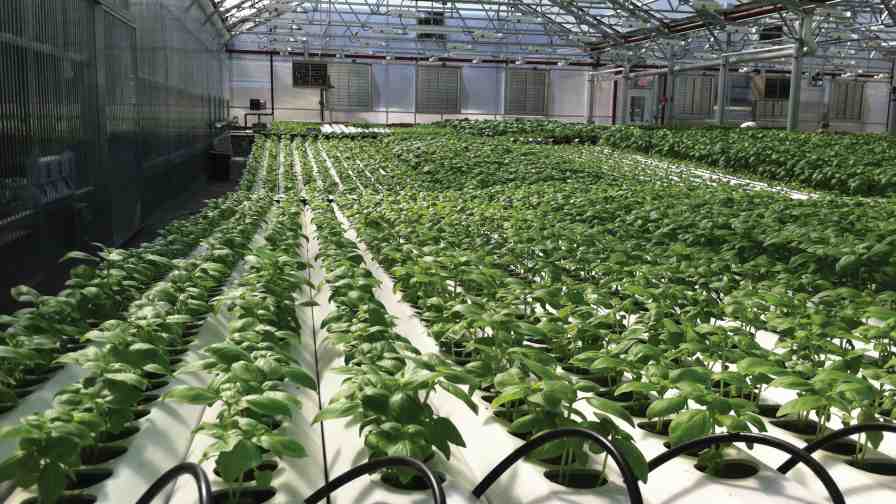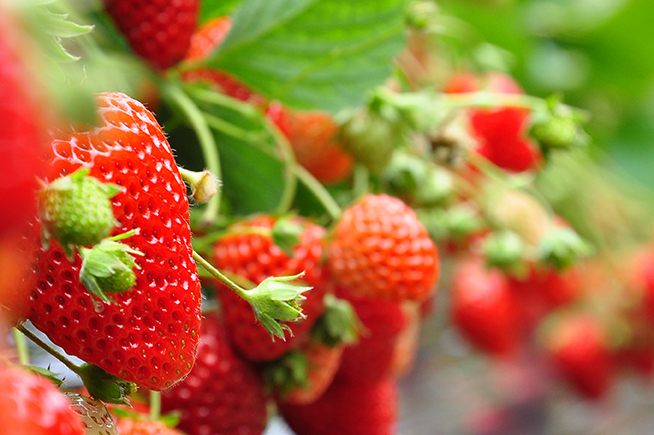Ensure Proper Lighting For Your Greenhouse Vegetables

Gotham Greens Greenhouse in New York uses supplemental high-pressure sodium lighting for its basil crop.
Photo credit: Chieri Kubota, University of Arizona

If you are an ornamental grower considering adding or switching over to vegetable crops in your greenhouse, there are many considerations for a successful transition.
One item to consider is lighting. It is a major element in greenhouse production and, for floriculture producers in particular, what has worked for them does not work for vegetables.
Chieri Kubota, a Professor in the School of Plant Sciences at the University of Arizona, provides advice on what lighting changes need to be made in your greenhouse to make sure your vegetable crops are receiving the correct amount necessary for adequate production.
Ornamentals Versus Vegetables
According to Kubota, while ornamental production is overwhelmingly concerned with quality, vegetable production also focuses on volume and size. The relationship between the amount of photosynthetic light the plants receive and their yield is almost linear with vegetables, Kubota says. Ornamental production does not exhibit that same relationship, so growers moving to vegetables will need to pay close attention to the amount of light coming into the greenhouse and the amount of light required by each crop.
“The first thing that ornamental growers aiming to produce vegetables want to do is find out what daily light integral (DLI) they have throughout the year,” Kubota explains.
DLI is the amount of photosynthetically active radiation (the range of solar radiation that is able to be used by organisms in the process of photosynthesis) received each day, expressed in moles per square meter, per day. [DLI is well defined in the article in this link: http://goo.gl/MUo1VT]
By measuring the DLI in your greenhouse and knowing the DLI that your crop requires, you can calculate the amount of supplemental lighting needed.
“Most vegetable crops have a specific minimum DLI level recommended. It is usually 12 moles per square meter per day. For crops like tomatoes and cucumbers, optimum DLI is much higher, around 30 or greater, while for other crops optimum is around 15 to 20,” Kubota says.
Measure Your Light
If you have not been measuring the light data in your greenhouse, you can use data from a weather station in your region, which records light statistics, as well as temperature, humidity, and wind.
According to Kubota, because the weather stations measure light data in energy-based units such as watts per square meter, which is not useful for greenhouse lighting purposes, you will have to translate the data into moles, allowing you to calculate your DLI. As an approximate conversion, 1 watt per square meter of solar radiation contains about 2 micro-mole per square meter per second of photosynthetically active radiation.
After you’ve calculated how much available light there is, calculate how much light is actually coming into your greenhouse.
“Growers need to measure multiple times a day to compare the light intensity outside and the light intensity inside using a sensor, and then average that ratio,” Kubota explains.
The ratio between the available light outside versus inside should be between 50% and 70%, with a 70% average being ideal. “For example, if the outside DLI is 10 moles per square meter a day, the inside should be between five and seven for most greenhouses,” she says.
Once you’ve calculated the DLI inside your greenhouse, preferably on a month-by-month basis, and have measured that against the DLI required for your crops, the next step will be to choose a supplemental lighting source.
Because there are so many lighting options, Kubota suggests first contacting a lighting company to help you come up with a design suggestion. The lighting company can help you determine what kind of lights you need, how many you need, where they need to be placed, and how long they need to be on to meet your crop requirements.
“Typically, vegetable crops are not as sensitive to day length as ornamental crops, so the lights can be on longer,” she explains. “Some crops like tomatoes don’t like 24-hour lighting. They show abnormal physiology under those conditions, so growers need at least a few hours of total darkness for the crop and should estimate the target intensity based on that.”
Changes To Your Greenhouse
Aside from supplemental lighting, there are a variety of minor changes you can make to your greenhouse to allow more light to reach your crops.
One of the first things is to make sure there’s nothing obstructing the light coming in, for example, hanging baskets, or anything attached to the beams. Another tactic Kubota suggests is to place a white cloth on the floor to reflect light.
“The floor surface color affects the total amount of light plants can receive, particularly at the beginning when the plants are still small. It gives the plants a second chance to get that wasted light that hits the ground first,” she explains.
Changing the glazing on your greenhouse may also make a difference, she says. The glazing affects whether the light coming in is diffused or direct, and by effect, how much light the plants are receiving.
“If the glazing material converts sunlight to more diffused light, it might help distribute the light lower in the canopy. Diffused light penetrates deeper into the canopy and reaches the lower leaves more efficiently than direct light,” Kubota says.
Lastly, she says plant density should be somewhere between three to four plants or stems per square meter.
“If your DLI is very low, you might try a much lower density. That way the amount of light available per plant is increased. Plants will be more vigorous compared to high-density situations,” she says.
Kubota’s final words of wisdom? “Pay attention to light, and read the data. With ornamental crops, the light and the moles are not as important as with vegetable crops. If you’re moving into vegetable crops, this would be the time to install your light sensors.









